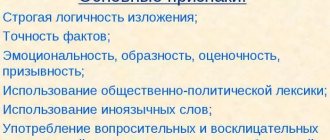The journalistic style of speech is a unique way of influencing huge masses of people. It is this type of text that can be seen in various newspaper articles, magazines, and other sources that express major social problems.
Substyles of journalistic style:
- newspaper and journalistic;
- television journalist;
- radio journalistic;
- direct contact with the audience.
Signs of journalistic style
You can understand that this is the style of speech in question by the following features:
- The validity and validity of statements that are used in speech. That is, the author of the text does not intend to distort reality in any way, but, on the contrary, strives to show the real sides of social life.
- Sentences in the text must be logically connected. People to whom the text is addressed in a journalistic style must clearly understand the problem of the text, its meaning and main idea in order to draw the right conclusions for themselves.
- Using a large number of questions and exclamations to decorate speech during a speech. Such articles are the most motivating and attract society.
- The text is filled with emotions and the author’s evaluative suggestions regarding the problem of speech. Speech is capable of influencing a huge class of people, therefore the text must be for the people. This is what distinguishes the journalistic style of speech from such styles as scientific, business or artistic. It uses colloquial language tools that are understandable to everyone.
- The presence of a socio-political set of words (citizens, democracy).
- Various slangs and short but expressive sentences are used here.
- Frequent use of proper names.
Problem article
We will pay special attention to this type of journalism, such as a problematic article.
Here, theoretical material is taken to a greater extent as a basis, theses are always supported by theoretical information and facts, different opinions on solving the problems raised are considered, and so on.
The problematic article is distinguished by a clear logical sequence of presentation
Mostly, the authors of problematic articles are scientists and specialists, given that they are not published in scientific literature, but in regular publications.
But regardless of this, the audience for this kind of article will be from a number of specialists in one or another scientific topic.
Characteristic features of the problematic article:
- clear logical sequence of presentation;
- the text can be emotionally colored by the author. This is done in order to emphasize the idea for the reader and make it interesting;
- use of a conversational style of speech. This is expressed in the reduction of long and cumbersome sentences, imitation of friendly communication between the author and the reader about serious problems, the use of colloquial vocabulary and emotional assessment of the topic raised;
- the debatable nature of the description of the selected topics.
The article as a genre in journalism will remain basic and most relevant for a very, very long time.
Even with the advent of the World Wide Web, the need for printed text did not fall, but on the contrary, it became many times greater.
Thanks to articles, you learn something new and interesting every day, so, to summarize, let us draw your attention to the fact that now you are reading an article.
In this video you will learn about two more genres of journalism - information and reporting:
Functions
This style of speech performs the following functions:
- Notification
— this function is aimed at transmitting information to a huge audience and, moreover, in a fairly quick period of time.
- Influential
— this function solves the problem of people’s interest in solving the problem being described, that is, the journalistic style of speech is aimed at attracting an audience.
- Conscription
— people should not only be interested in the problem, but should be eager to solve it and take some action.
Genres of Soviet journalism and their modern transformations
It wouldn't hurt to say a few words about the well-forgotten old things. In Soviet times, journalism lived according to special laws. There was a different classification for articles: problematic, advanced and theoretical-propaganda varieties were distinguished.
The problematic article is intended to explore and, if possible, resolve acute social and moral contradictions that arise as society develops. Its distinctive feature is its controversial nature.
The editorial expresses the opinion of the editorial team (optionally, and the ideology of a certain part of society or state power standing above it) on topical issues.
The genre is heterogeneous and can be divided according to the method of presenting the material into staged and polemical articles, according to the depth of generalization - into problematic and operational ones, as well as by topic.
The Soviet “Editorial” opened the next issue of the printed publication and, with its characteristic categoricalness and evaluativeness, spoke about the comprehensive superiority of communist society over the “decaying West”, was filled with deep generalizations and contained recommendations for the further development of the country.
Currently, the half-forgotten genre is gradually returning to newspaper pages. Having lost, in most cases, ideological edification, the editorial retains the function of formulating the editorial line in relation to an event significant for the country or determines the topic of the issue, which is more typical for magazines.
A theoretical propaganda article has similar tasks: it forms a political, moral or scientific worldview. This is achieved by explaining new phenomena or ideas, revealing the meaning of modern social processes.
Texts of this type are characterized by unobtrusive persuasion using the method of confidential conversation with the reader, evaluative description and selection of life examples. The language should be simple and the reasoning logical. Nevertheless, as a result of reading, the addressee should come to clear conclusions.
Scope of application
If the goal of this style of speech is to convey a public problem to the audience, then it is used where there will be the most readers/listeners/subscribers:
- newspapers magazines;
- radio journalism, television journalism;
- speeches by political parties, rallies, calls for strikes, etc.
What is text style
Text style is a system of means of expressive language that is usually used in a certain communicative environment.
Its application depends on:
- the situation in which the text is used;
- audience of readers;
- storytelling purposes.
One and the same phenomenon can be written in completely different ways. Here is an example of describing rain in different styles:
- The Ministry of Emergency Situations warns that heavy rains with hail and wind gusts of up to 20 m/s are expected in the next 24 hours.
- The first autumn rain was pouring outside the window. The puddles reflected yellowing, and in some places still green, foliage. The wind exposed the dark branches of the trees and tore up the withered leaves. The sidewalks looked like raging rivers overflowing their banks.
In the first case, an official business style is used. It is intended for a wide audience. Its goal is to convey information dryly and concisely without using any means of expression, to warn the reader about bad weather.
The second example uses an artistic storytelling style. Means of expression are used: epithets, metaphor. Its goal is to describe the beauty of nature, to create a certain visual image in the reader. The audience is readers of fiction.
Lexical features
Some lexical features of the style can be noted:
- the predominance of colloquial and socio-political vocabulary;
- use of particles and interjections;
- words are colored emotionally, expressively;
- the use of excessive exaggeration - hyperbole.
How to Define Text Styles
If you carefully familiarize yourself with the features of each text style, you will be able to recognize it without much difficulty. To do this you need:
- Understand where the text is written and to whom it is addressed. If you have a fiction book in front of you, then the style will be artistic. If the article is in a scientific journal or textbook, then most likely the text is written in a scientific style. The journalistic style can be seen on a news portal, in a popular magazine, or in a newspaper article. Only official business style can be used in official documentation and business papers.
- Pay attention to the vocabulary. If you see slang or colloquial words, then the text style is conversational. Special terms are found in scientific texts, and clericalisms are found in official business texts.
- Decide on the purpose of the text. The educational material is designed to logically convey knowledge to the reader. If the purpose of the text is to convey a certain idea, thought, or discuss a topical topic, then this is most likely journalism. A literary text aims to create in the reader an image, a picture of the phenomenon or event being described. The purpose of a business document is to convey information in a concise form, as specific as possible.
Speech style definition scheme
Usually at the third step you can say with confidence what style of text is in front of the reader.
In this chat you can ask questions regarding text styles, or share your knowledge:
Morphological features
Morphological features include:
- frequent use of synecdoche - the plural is replaced by the singular or vice versa (fathers, grandfathers, Russian, French
);
- frequent use of imperative verbs (look, think
);
- use of all forms of adjectives (regular, comparative and superlative).
Syntactic features
The following apply:
- The use of various figurative and expressive means of language, expressive sentences and tropes to decorate speech (for example: epithets, rhetorical questions, appeals, parcellation, exclamation, gradation, etc.).
- Attractive text title.
- Expressiveness of short sentences.
- Direct speech.
- Separate structures.
FEATURES OF NEWSPAPER GENRES
Text publications in the newspaper differ in content and form. One of the most important elements of the publication form is its genre. The genre of as the stable features of its content and thematic characteristics, the type of reality displayed, composition, and stylistics. These features of the genre do not depend on the will of the journalist; on the contrary, having chosen a genre for his publication, he is forced to take into account its features and capabilities.
Genres exist not only in journalism. The same stable meaningful forms of works are also addressed in other areas of creative activity. Literary genres are known: in prose this is a story, short story, story, novel, in poetry - a poem, poem, ode, etc. Composers choose musical genres for their works - sonata, symphony, concert, opera, etc. And scientists use those that have been established in time genres of scientific works - article, report, dissertation, etc. The choice of a specific genre helps the author of the work in the process of collecting material, processing it, and achieving the intended goal.
In each area of creativity, genres have their own specifics. This also applies to journalistic works - to publications of all types known to us in printed periodicals. And, above all, to the genres of newspaper journalism.
The emergence of a particular genre and its development is explained, first of all, by the need for it. Just like the birth of the first newspapers and magazines, it is explained by the emergence and strengthening of information requests of representatives of certain social groups that were formed in the most developed European countries. We should not think that the genres of journalism we now know were once invented, developed by one of the journalists trying to comprehend the process of their activity. In fact, each of the genres of journalism arose as a result of a reaction to the emergence of information requests from readers of printed periodicals. The demand for journalistic information gave rise to a supply of journalistic texts that had certain features. With the emergence of the international market, merchants, traders and entrepreneurs felt the need for information about the production of various goods and their prices in different countries and cities, about the arrival of ships with overseas goods in ports, about clashes between the armies of different states, about changes in rulers, etc. Newspaper publishers satisfied this need by publishing concise reports on the most important political and economic events taking place in the countries where they were located. This is how a genre arose, which was later called the note. When, during the clashes between Protestants and Catholics in Europe, with the strengthening of the bourgeoisie striving for political power, the need for ideological weapons arose, this quickly led to the appearance of texts distributed in the form of leaflets and posters, and then newspaper publications, later called pamphlets . This is how other genres of journalism were born and formed.
This process continues in our time, leading to the emergence of new genre forms.
What determines the use of journalism genres in printed periodicals? What influences a journalist’s choice of one genre or another in a newspaper? The genre system of its publications is formed under the influence of a number of factors – objective and subjective. The first include the type and level of the publication, the characteristics of its readership, the frequency of publication of issues and the composition of the creative team. The second is the professional level of the journalist, his creative interests, the reason for working on the text: an editorial assignment or an independent choice of the object of study. And in particular, understanding the role of each genre and its specifics.
A professional journalist is required to master the vast majority of genres of journalism - with the exception of some, which require a special creative gift to address. For example, in order to write a real feuilleton or pamphlet, a journalist needs satirical talent - not everyone can call themselves a satirist. However, in practice, most journalists limit themselves to a few of the most popular genres of journalism, and some even specialize in using one or two genres. Note that some positions of creative editorial staff require them to use a certain limited genre “palette”. Thus, a newspaper columnist usually publishes reviews, articles and comments, and a reporter acts as the author of operational notes, reports, reports and interviews - he does not write articles and reviews. In a large editorial office, “narrow specialists” can also work, speaking only in one genre - feuilletonists, interviewers, or even reviewers. For several decades, Lev Kolodny worked as the information department of the editorial office of the Moskovskaya Pravda newspaper, publishing only reports devoted to only one topic - about Moscow and Muscovites.
The choice of one genre form or another is dictated not only by the requirements of the editorial plan and the creative interests of the journalist, but also by its features and characteristics. These include: the purpose of the genre, the object, the subject and methods of display, means of expression, the style of the text and the role of the author.
The most important thing, of course, is the purpose and function of the genre. The purpose of the note is to communicate news and operational information. The purpose of a report is a story about an event by an eyewitness or participant. The choice of correspondence is determined by its purpose - a form of analysis of a specific situation. When an author sets himself the task of creating a journalistic image of a person, he turns to an essay. When he needs to speak out against social evil, to reveal the negative character traits of a person, he chooses the genre of feuilleton. The journalist knows or intuitively comprehends the intended purpose of various genres and addresses them in accordance with the task he is solving. The wrong choice of the genre of his speech in the newspaper may prevent him from successfully completing the task received. He will not be able, for example, to convey his impression of meeting an interesting person in correspondence; for this he will have to write a sketch or even an essay.
Each genre of journalism has its own object of display. This is the area of reality that the author of the text explores. A newspaper reporter can write a report about everything that he saw, what happened before his eyes - about a heroic act and about a natural disaster, the topics of his speeches are not limited - in accordance with the events that he witnessed. The observer reveals in his review a panorama of events that took place during a certain period in a certain area of life - politics or economics. The object of display in the reviewer’s works is literary life or what is happening in another field of art.
However, when a journalist turns to a specific genre, the object of display is specified in the subject of display. An information note is dedicated to a specific fact. The author of the report focuses on showing the event and its development. The article reveals a certain idea or analyzes a current problem. The interviewer is interested in the opinion of the person he is interviewing about an event or situation. And the essayist strives to reveal the character of his hero, the most important features of his psychology, explaining his actions in a specific life situation.
Genres also differ in their stylistic features. The note is written extremely concisely and simply, there is nothing superfluous in it. The reportage has a different style - its author uses bright epithets, colorful comparisons, details and details; his story is dynamic and emotional. The style of the article is characterized by efficiency, richness in reflection, and reliance on facts. By revealing his thoughts, the author seeks to convince the reader that he is right, giving arguments that support his conclusions. When starting to write an essay, the journalist pays attention to the imagery of his language and style; his text is in many ways similar to a work of art, differing from it, however, in the main thing - it is strictly documentary, there is no place for fiction. And the feuilleton is characterized by the active use of satirical means - irony and ridicule, hyperbole, sarcasm and grotesque.
Without taking into account the most important stylistic features of various genres of journalism, it is difficult to create a journalistic text. Of course, in an article you can use an ironic comparison or hyperbole, and even in a note recall a famous literary image, but such a style is uncharacteristic for these genres. But without relying on the details of what the reporter is talking about, he will not be able to provide the effect of the reader’s presence at the scene of the event and create a real report.
means of expression when addressing a particular genre of journalism is even more important Her texts use facts, concepts and images. They can be likened to the bricks from which buildings are built. In journalism, this is a journalistic fact, which is a reflection of a real fact. A concept is the result of understanding a fact, embodied in a certain thought, idea, reasoning, etc. An image in journalism is a compressed representation of a real object - an object, a person, a situation, which allows you to quickly get an idea of its most important features and characteristics. These expressive means are used in different genres in different combinations. Journalism is factual; facts form the basis of all its genres. The specificity of the genre chosen by the author is determined primarily by its purpose and the use of various means of expression.
GENRES OF NEWS INFORMATION
In modern newspaper journalism, about two dozen genres are used. They form a kind of chain, the links of which make it possible to move from the simplest genres to more complex ones. Depending on the purpose of the genres, they are combined into several groups. The first of them is the genres of news information: note, report and report.
These genres are turned to when trying to tell readers news. By news we mean something that is unknown to the entire readership of the newspaper or at least part of it. However, not every fact, not every event can be of interest to readers and become news. It depends on the relevance of the fact - its social significance. What is relevant is what attracts the attention of readers, arouses their interest - personal and social. A fact can remain relevant for a long time or quickly lose it - it depends on many circumstances. Including the scale of the fact. Some facts are relevant only to a limited audience, others are of broad public interest. In determining their relevance for a newspaper, its type and level play a significant role. So, for example, the decision of a university student to start a new family is unlikely to become a reason for a journalist of a city or regional newspaper to write a report or at least a note - the scale of this fact is too small for such a publication, in our time such an event has become ordinary. But a grassroots university newspaper may publish a note about it; for a narrow student audience it remains relevant.
When looking for up-to-date information, you should distinguish between news and new. News is something that is unknown to all or the vast majority of readers. New is the unknown about what is already known. Let's illustrate this with an example. More than a century ago, one of the German doctors discovered the remarkable healing properties of aspirin, which has since become a common medicine for colds, flu and other infectious diseases. The press hastened to inform a wide audience of this very relevant news. However, only recently was the previously unknown ability of aspirin discovered to prevent human blood clotting and the formation of blood clots, which are the cause of many heart attacks and strokes. Journalists, of course, did not hesitate to inform readers in their notes of this new, relevant information for many about a medicine known to everyone. For many readers suffering from heart disease, it became sensational news.
To receive news that is of interest to all readers and has a strong impact on their feelings is the desire of all newspaper journalists. Such news remains relevant for a long time, it is highly valued and leads to a rapid expansion of the publication’s audience.
The goal of the author of the note - to inform the reader of current news as quickly as possible - determines the main features of this genre of newspaper publications. First of all, its structure: it usually represents a kind of inverted pyramid - it begins with a supporting fact containing the news, and then further details it in subsequent sentences. This structure of the text makes it easier to perceive and, if necessary, shorten it - from the last paragraphs or lines, the essence of the message remains unchanged in the initial paragraphs. The desire to ensure prompt transmission to the reader of the information contained in a note limits its volume: usually it does not exceed two to three dozen lines, and is often limited in an extremely laconic operational message - a variation of this genre - to just one or two sentences. The same explains the peculiarities of the note's style: it avoids stylistic beauty, it is businesslike, sometimes dry, but accurate.
The author of the note does not require detailed descriptions and characteristics. But he is obliged to answer a “triad” of questions: What happened? Where did it happen? When did it happen? Sometimes this is accompanied by an answer to the fourth question: Who participated in the event? This is enough to report the news. Its significance will be explained in subsequent reports and correspondence.
The title of the note has its own characteristics. Often notes are published in blocks, collections, without headings - under thematic headings. More often, however, the note has a title. Usually it contains an indication of the supporting fact of the note, then the title conveys its essence: “A monument to the legendary priest-surgeon was unveiled,” “Oil exports are increasing,” “Car accident in Novosibirsk,” etc.
The role of the author of the note is limited to communicating information and is sometimes indicated by his signature. However, this does not mean his passive attitude towards the fact that he reports in the note. The very choice of this fact fixes the author’s position – his interest in obtaining this information.
The journalist’s attitude to the event that attracted his attention is revealed with even greater certainty in the report , a genre that very often appears on newspaper pages. The author of the report does not limit his text to answers to questions required for the note. Its purpose is to report significant details of the event it describes. The volume of the text increases, as does the role of the author, who can, if he considers it necessary, accompany the message with his commentary and assessment. The report has its own subject of display: an event unfolding over time, consisting of a number of details. Most of the events depicted in this genre have a specific oral form of expression of content; they can be heard - then reports on a conference, meeting, meeting of politicians, court hearings, etc. are published. Sometimes an event can be observed and a report of a sports match or demonstration appears in the newspaper.
Newspapers use different types of reporting. The simplest of these is a direct information report. It reproduces an event in full accordance with its course in time. Often, speeches from participants in events - meetings, conferences, etc. - are given here. - in a concise retelling, presentation of the most important thoughts and positions, interspersing this with quotes from the most interesting statements. The author's assessment of speeches is expressed in the selection of facts, details and details. Everything that the journalist considers unimportant, he leaves out of the report.
Often the author of a report not only reports an event, but also seeks to comment on it. He takes a more active role in his text. His commentary can take various forms of concise characteristics that give an idea of the meaning of a speech or the reaction of other meeting participants to it, or it can be expressed in brief authorial digressions and even in a concise polemic with the speaker. Sometimes the commentary takes the form of an introduction to a report, revealing the purpose of its publication, or in the author's conclusion, summing up the discussion. As a result, an analytical report appears in the newspaper. The point of view of the journalist and the editorial board receives detailed expression here.
A type of analytical report is a thematic report. It is dedicated to the most pressing topic, the most important problem raised at a meeting or meeting. In accordance with this, the report material is grouped, minor details and details are omitted. Such a report sometimes reports only a few speeches that are thematically related. Or they devote it to one most important speech, reporting the rest in a brief retelling.
Sometimes reporting an event in a report is used only as an excuse to raise pressing questions. The author refuses to provide detailed coverage of the event as a whole, using its individual elements. In such a problem report, the analysis goes far beyond the initial event, capturing new facts necessary to pose an important problem. The author of the problematic report not only assesses the event, but also reveals the significance of issues of great public importance. The report acquires features that bring it closer to the problematic article. It differs from a direct information report both in its freer composition and style. In general, the reporting style is characterized by efficiency, economy, and the rejection of everything that interferes with the transfer of the main thing. However, if necessary, in an analytical and especially a problematic report, figurative language means are used - metaphor, vivid epithet, comparison, etc. They help the author express his attitude to what is being reported and recreate the atmosphere in which the event took place.
Expressive language means are especially often used in reports on events taking place in a visible form - folk festivals, sports competitions, etc. Such reports are characterized by an emotional style.
It is useful to plan the publication of reports in the newspaper. This will allow, on the one hand, to avoid overloading the newspaper issue with texts in this genre. On the other hand, it will give the journalist the opportunity to better prepare for writing a report, and to get at least a preliminary idea of what the event will be devoted to. The choice of the topic of the report and its form usually occurs at the scene of the event, in the process of its development. This predetermines the need for the author of the report to be present at the scene of the event about which he is going to report. Only in some situations, when it is impossible to ensure the presence of a journalist at a meeting or assembly about which he must publish a report, is he allowed to write it using minutes, text or abstracts of the report, voice recording of speeches, etc.
Reporting is a treacherous genre. The idea of some novice journalists about the ease of preparing text in this genre very often leads to creative failures. To the publication in the newspaper of bloated, boring reports, often occupying entire pages. To avoid such failures, the author is required, first of all, to be able to find relevant news even at a boring meeting, at a useless meeting. If this turns out to be impossible, the journalist has a reason to write a critical report analyzing the reasons for the failure of the event organizers.
One of the most popular genres of newspaper journalism is reportage (from the Latin reportare
– to report, to convey). Popular with both readers and journalists. This is explained by the peculiarities of the genre, which open up wide opportunities both for the author of the text and for its reader.
The purpose of a report is more complicated than a report. The reporter strives to show the reader as quickly as possible a picture of the event at all stages of its development - from beginning to completion, to quickly recreate the “history of the event” as an eyewitness or participant. This is an intelligence genre; journalists turn to it, trying to report on what is happening in our country and abroad.
The subject of the report is an event that combines visual and oral forms of expression of its content. The author faces a difficult task: to achieve the effect of the reader’s “presence” at the scene of the event. This is possible, of course, only with the presence of the author himself at the scene of the event. His role is great: he reports, sometimes becoming not only a witness to an event, but sometimes even its initiator and organizer.
Not every event is worthy of coverage in a report. The criterion for choosing an event is its relevance, social significance. The reporter's story should reveal to the reader some new side of reality, the process of its change. This predetermines one of the important features of the genre - its dynamism.
The reporter's task and the subject of the report determine other important aspects of it. In particular, its “visibility”: the reader must, as it were, see everything that is happening at the scene of the event, as if hear the voices of its participants. This effect is achieved primarily by using details and details in the text of the report that help the reporter draw a visible picture of reality. And if he turned out to be a direct participant in the event that he wants to talk about, this gives him the opportunity to experience those feelings himself, to experience the excitement that other participants in the event experienced. This will allow it to have a stronger impact on readers. At the same time, he does not just record the details of the event that he noticed, he selects facts, groups them in the text, recreates the event, while reflecting his attitude towards it.
The thematic range of reality phenomena for which reportage is used is almost unlimited. Depending on the sphere of human life and society, various thematic types of this genre are distinguished: scientific reporting, sports, social, etc. The task that the author sets for himself determines the features of his work. In an effort to promptly inform readers about a current event, he creates an event report. But he may not connect his text with a specific one-time event, but talk about some invention, creative process, or interesting person. Then an informative report appears in the newspaper - from an artist’s studio, from a museum, a scientific laboratory, a book depository, or from a writer’s office. Such reports are not as immediate as event reports; they are usually planned in advance.
Often the scope of a purely informational report turns out to be too tight for the author. He is not limited to recreating the picture of an event, but seeks to subject it to analysis, compares facts, explores their connections, studies causes and consequences. The experience of M. Koltsov, A. Gudimov, A. Rubinov, V. Peskov and other well-known domestic publicists shows the wide possibilities of using problem reporting in a newspaper.
A. Gudimov's reports on economic topics were distinguished by their desire to reveal all aspects of the problem being studied, related to the work of capital taxis, traffic police inspectors or grocery store sellers. In his publications related to the “secrets of other people’s professions,” vivid episodes were interspersed with parts in which the author worked as an experienced economist and carried out complex calculations - with him, numbers became a means of persuading the reader.
The basis of A. Rubinov’s problematic reports is a carefully thought-out experiment. The journalist recreated a well-known life situation - when looking for medicine in a pharmacy or when buying a ticket at a railway ticket office - and then, as a participant in this situation, he comprehensively examined it. In this case, the author’s reasoning, his study of the facts, his emotional reaction to them and his conclusions and suggestions on how to eliminate the shortcomings come to the fore. This is how the journalistic nature of emotional analysis was achieved.
The author’s ability to “conduct” a report and “edit” its parts determines the features of his composition. In cases where the author talks about a journey, his route most often determines the composition of the text. This is how, for example, L. Kolodny’s reports in Moskovskaya Pravda about his “journey” around the capital along the ring road were structured. In other cases, the report is based on finding out the circumstances in which the event took place, on the “search” for the people depicted in the photograph, etc. The author of such a report acts as a researcher; he is required to be able to use a record of a surname or a line from a document as a reason for creating a reportage narrative in which history is directly related to modernity.
The specificity of the report is also evident in its style - emotional, energetic. It is characterized by the active use of means and techniques of figurative representation of reality - a vivid epithet, comparison, metaphor, etc. And, if required, even some satirical means. The effect of presence, which was mentioned above, seems to include the effect of empathy: the report will achieve its goal if the reader, together with the reporter, admires, is indignant, and rejoices. And it is no coincidence that a report is often defined as an “artistic document.”
DIALOGICAL GENRES
Interview, dialogue and conversation (polylogue) form the next group - dialogical genres of journalism. They have a general purpose and a specific subject of display - with the help of these genres, journalists report not only about events, but also about people’s opinions about these events. And they differ in the number of participants, their role and methods of obtaining information.
An interview always involves two interlocutors – the interviewer and the interviewee. In this case, the main role is played by the interviewee, from whom the journalist obtains information of interest to him, and also finds out his opinion about the facts and situations that he reports. This role varies depending on the type of interview that the newspaper intends to publish.
The vast majority of texts in this genre are oral interviews, the material of which the journalist receives during a direct meeting with the person who interests him. But sometimes a written interview appears in the newspaper. The journalist receives its text when it is impossible to meet in person with the interviewee, for example, with a government official who does not find time to talk with a newspaper representative. In such a situation, a journalist can, having agreed with the press secretary of the person he would like to interview, send him a written message with questions, the answers to which the editors are waiting for. The text of these questions and the answers to them are published in the newspaper in the form of an exclusive interview.
A type of written interview is also represented by questionnaires often published in newspapers with questions for readers. Answers to such a questionnaire allow the editors to get a better idea of the newspaper's readership.
Often a monologue interview appears in the newspaper. After a single question from the journalist, a lengthy answer from the interviewee follows; the text takes the form of his monologue. But most of the texts in this genre are interview-dialogues.
Interviews are also differentiated by the number of participants. Often a journalist has to participate in a press conference and then publish a text - the result of a collective interview. A press conference may involve one or more interviewees, for example, members of the regular crew of the international space station, who answer questions from several journalists representing different media. A variation of such a collective interview is a text prepared by a participant in a press release - a meeting with a representative of a government or commercial organization who conveys relevant information to journalists.
The success of an interviewer depends, first of all, on his preparation for the interview. And it begins with choosing the person he intends to interview. It is clear that interesting information can be obtained from a person who is sufficiently competent in the situation that interests the editor, and whose opinion is of interest to the majority of readers of the newspaper. Only in some cases, when the editorial office needs to quickly get an idea of the reaction of citizens to an event, editorial staff take micro-interviews, asking questions to the first people they meet on the street.
Having agreed on the time and place of meeting with the person chosen for the interview, it is useful to first collect information about him - about his range of interests, the results of his activities, the characteristics of his character. If we are talking about a scientist, try to get acquainted with his works in the library; if you are going to meet with a deputy of the local Duma, get an idea of his biography, political preferences, range of responsibilities and interests, etc. And after that, devote some time to understanding and recording on a piece of paper the questions to which you would like to receive answers during the interview. You shouldn’t go to an interview without such questions: during the conversation they may change, new questions will arise, but the interviewer has no right to forget about the main purpose of the interview.
One of the conditions for a successful interview is to ensure that the information obtained during the conversation is recorded. The best option is to use a voice recorder during the interview (only with the consent of the interviewee), but in its absence, it is useful to record the most important information in a journalist’s notebook; You shouldn’t rely only on your memory, it can let you down.
The last stage of working on the interview is processing the information obtained during the interview. The journalist builds the text, freely choosing its form. But in any case, he is responsible for the accuracy of the reproduction of the information conveyed to him by the interlocutor. He acknowledges his responsibility in the introduction to the interview, announcing its topic and introducing its participants, or with his signature at the end of the text.
The author of the interview may not limit himself to faithfully reproducing the information and opinions of his interlocutor. His role increases if desired. He conducts an active dialogue: not only asks questions, but supplements the answers to them with his own information, even, if necessary, challenges the interlocutor’s statement.
The so-called sketch interview has increased efficiency. Its author is not limited to reporting information received from the interlocutor and his opinions. He strives to reproduce the environment in which the interview takes place, uses a meeting with an interesting person as an occasion to talk about his life, character, achievements, and reproduces excerpts from his memories. The interview includes elements of reporting.
Interview is a flexible conversational genre. This predetermines his style - free, expressive, full of vivid comparisons, characteristics and other figurative elements. And at the same time, ensuring accuracy in transmitting information and reproducing a person’s opinion.
Dialogue was previously considered a type of interview. But its characteristics gradually crystallized, giving the right to consider it an independent genre of journalism. It differs from an interview, first of all, in the number of participants - it increases to three. In addition to the presenter-journalist, two more participants are presented in the dialogue. Each of them has their own role. The journalist prepares a dialogue and, if necessary, conducts it, “throwing” questions at its participants. And the latter are actively discussing the current problem, exchanging opinions, arguing with each other, defending their positions.
Usually in a dialogue there are representatives of one particular area of social life: literature - a writer and a literary critic, music - a composer and a musicologist, science - two scientists representing different scientific schools, etc. This is a conversational genre, and the journalist’s duty is to record the process of dialogue, all the information that arises during its course. And then select the most essential and write a text, including your introduction, which explains the purpose of the dialogue and introduces its participants, and the conclusion, where the results of the dialogue are summed up and the most important conclusions are formulated. Of course, he is obliged to maintain objectivity when assessing the positions of the participants in the dialogue and formulating his attitude towards them.
Dialogues appear in the newspaper that are prepared using a different method. In an effort to highlight a pressing problem and to bring opposing points of view together on the possibility of solving it, a journalist commissions two authors with opposing positions to write two texts expressing different points of view. Then he brings them together in the newspaper side by side on one page, thus creating a kind of correspondence dialogue. If necessary, the journalist concludes it with his own text, formulating the editorial position. Similar dialogues are sometimes published in the Izvestia newspaper.
a conversation (polylogue) in the editorial office and prepares a text about it for the newspaper, increases even more The number of its participants is not limited and is determined by the need for the most complete coverage of the chosen topic or problem. A newspaper representative selects participants for the conversation and invites them, informing them about its topic. The presenter journalist begins the discussion, poses questions to its participants, and everyone freely – on an equal basis – expresses their opinions. The author of the text is faced with the difficult task of selecting the most relevant things from the recording of the conversation and combining them into a single whole that gives an idea of the course of the conversation.
Linguistic means of journalistic style
Among them:
- epithets
, expressed by evaluative and emotional feelings;
- comparison
using the words
“as”, “as if”
; - metaphor
– transfer of characteristics and properties from one object to another;
- metonymy
- replacing one concept with another.
For example: “Russia is rejoicing”
(that is, the population of the country, Russians); - hyperbola
;
- irony
;
- paraphrase
– avoiding repetition.
For example: “our little brothers”
(animals).
Examples of texts in different styles
To better understand what the text of each style looks like, let’s give some visual examples.
Scientific
Here is a short text from a physics textbook:
Example of scientific style
Here we see special vocabulary:
- "electrical circuit";
- "voltage source";
- “current consumer”;
- "resistor";
- "conductor";
- "voltage";
- "load".
The sentences are complex. There is an introductory construction “by the way.”
Official business
An example of an official business style - instructions for filling out a car purchase and sale agreement:
Example of formal business style
The vocabulary of this text is dry, without epithets and bright emotional coloring. The audience is narrow - the participants in the transaction or the person who will fill out the document. The agreement is also drawn up in an official business style.
Art
The description of the oak tree in Leo Tolstoy's famous novel War and Peace is a striking example of artistic, or literary, style:
Example of artistic style
The text contains many epithets and adjectives, comparison, metaphor, allegory. The oak is compared to an old man, and the branches are compared to gnarled fingers.
Journalistic
An example of journalism - a description of a completed project on a news portal:
An example of journalistic style
The text is emotional, evaluative, inviting. The author's point of view is visible. Addressed to a wide audience of readers. Raises the topical topic of waste recycling. All these are signs of a journalistic style.
Colloquial
As an example of colloquial speech formatted into text, we give a description of the well-known keyboard simulator Stamina. The author made the instructions in the form of a blog, communicates with readers in simple colloquial language with humor, slang and a bright emotional coloring of speech:
Conversational style example











